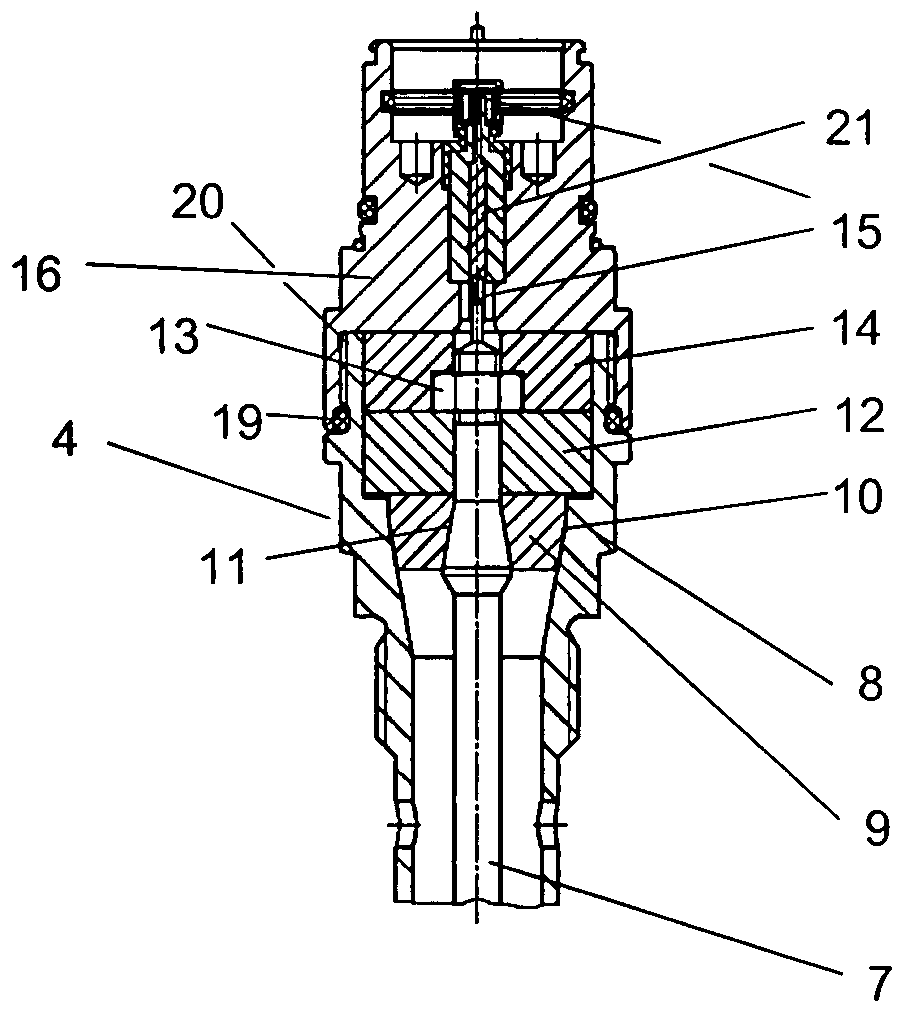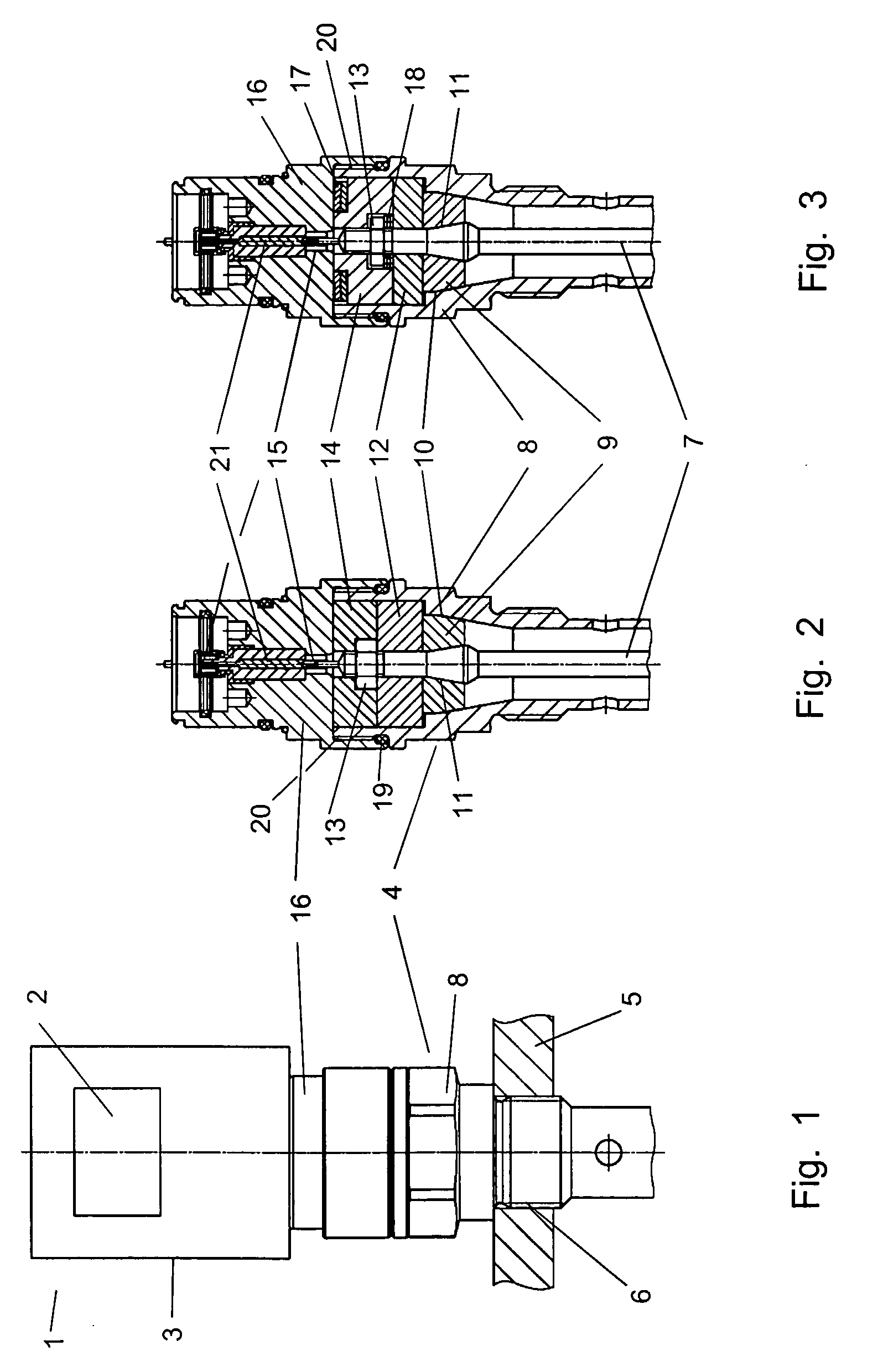[0016] One
advantage to be attained with the present invention is therefore that due to the precise fit achieved by the
machining of the circumferential surfaces of the essentially concentrically arranged components of the guide-through assembly no additional sealing elements need be arranged, so that despite any pressure and / or temperature influences the seal between the interior of the vessel and the interior of the sensor can be permanently ensured. Another
advantage of the present invention is that due to the
elimination of additional sealing elements, the entire guide-through assembly has a simpler and cheaper construction. Another possible
advantage of the present invention is that despite any temperature and / or pressure influences the sealing between the interior of the vessel and the interior of the sensor is permanently ensured, which permanently ensures the operating safety of the entire filling level sensor.
[0017] According to another aspect of the present invention, the guide-through assembly has a process connection arranged within an interior conductor which on the one hand extends through a
solid-state insulating body which both surrounds the interior conductor in a positive engagement in a sealing way on its circumferential surface and also fits in the process connection in a positive engagement. As can be seen, the exterior circumferential surface of the interior conductor contacts the insulating body in a closely adjacent relationship, which in turn has its circumferential surface entirely closely fitted in the process connection. By having the insulating sealing body prefabricated as a
solid body whose circumferential surface is manufactured to such precision that it sealingly contacts the corresponding circumferential surfaces of either the interior conductor or the process connection, additional sealing elements, for example of elastomeric material, are not needed, which are usually affected by the above-described sealing problems due to the effects of high pressures and / or temperatures.
[0018] While the adjacent circumferential surfaces of the process connection, the interior conductor and the insulating sealing body may be machined to such precision that they contact each other so tightly that in the optimum case no
gas exchange is possible through each adjacent pair of circumferential surfaces, the insulating sealing body is made of a plastic material to compensate for any unevenness due to surface defects of the circumferential surfaces, since the plastic material can compensate such unevenness due to a certain resilience. Preferably, the insulating sealing body is of a temperature-insensitive, resilient, pressure-resistant,
creep and / or flow-resistant plastic material with
dielectric properties, such as a
polyimide, which helps to ensure that the guide-through assembly situated between the interior of the vessel and the interior of the sensor remains permanently sealed, also in unfavourable
process conditions such as chemical influences, atmospheric process pressures and high temperatures. Trials have shown that the VESPEL® material, especially the SP1 type, is particularly suitable, while other types of VESPEL® or similar generic materials can, of course, also be used in corresponding conditions of application.
[0019] The materials which have been shown to be particularly suitable for the insulating sealing body are distinguished by their good form and dimensional stability, which is due to a well adjusted combination of the essential material parameters. It may, for example, be important that the materials have no discernible
softening or
melting point. Also, low coefficients of
thermal expansion and excellent
creep and brittling resistances help to keep dimensions stable. Due to this stability, the insulating sealing body can be made to such low tolerances as have been inconceivable with
plastic materials before. This dimensional stability results in the sealing member, for example of VESPEL® or a
polyimide, keeping its
form and function also in extreme
process conditions. The materials which have shown to be particularly suitable, such as VESPEL® or
polyimide, combine the favourable dimensional stability with a
toughness which conventional
plastic materials usually lack. Moreover, these materials have shown to be suitable because they do not melt at temperatures as high as about 290° C. and, for short durations, as high as about 500° C. and therefore remain uniformly dimensionally stable and strong also with high temperatures over longer periods of time.
[0020] As can be seen from the preceding explanations, the interior conductor is circumferentially surrounded by the insulating sealing body which, in turn, is fitted into the process connection. In order to simplify terminology in the following, the exterior circumferential surfaces of the interior conductor, which the insulating sealing body circumferentially contacts in a positive and therefore sealing engagement, will be referred to as the outer circumferential surface of the interior conductor. Similarly, the insulating sealing body has an interior circumferential surface which contacts the exterior circumferential surface of the interior conductor in a positive and therefore sealing engagement and exactly fits onto the latter. Similarly, the insulating sealing body also has an exterior circumferential surface, while the process connection also has an interior circumferential surface which in the assembled state of the insulating sealing body within the process connection fit together in a positive and therefore sealing engagement.
[0021] According to another aspect of the present invention, both the interior circumferential surface of the insulating sealing body and the exterior circumferential surface of the interior conductor have a conical or tapered section, wherein the contours of the two sections are complementary to each other and fit together closely in a positive and therefore sealing engagement, so that the interior conductor can be fitted into the corresponding section of the insulating sealing body in a sealing manner. Similarly, both the interior circumferential surface of the process connection and the exterior circumferential surface of the insulating sealing body have a conical or tapering section, wherein the contours of these two sections are complementary to each other and fit into each other in a positive and therefore sealing engagement, so that the insulating sealing body with its conical or tapering section can be fitted, fully sealed, into the corresponding section of the process connection.
 Login to View More
Login to View More  Login to View More
Login to View More 

